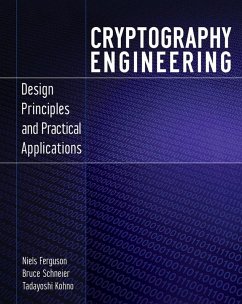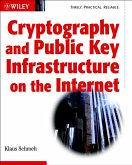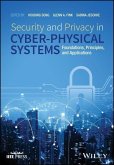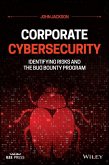Cryptography Engineering (eBook, PDF)
Design Principles and Practical Applications


Alle Infos zum eBook verschenken

Cryptography Engineering (eBook, PDF)
Design Principles and Practical Applications
- Format: PDF
- Merkliste
- Auf die Merkliste
- Bewerten Bewerten
- Teilen
- Produkt teilen
- Produkterinnerung
- Produkterinnerung

Hier können Sie sich einloggen

Bitte loggen Sie sich zunächst in Ihr Kundenkonto ein oder registrieren Sie sich bei bücher.de, um das eBook-Abo tolino select nutzen zu können.
The ultimate guide to cryptography, updated from an author team of the world's top cryptography experts. Cryptography is vital to keeping information safe, in an era when the formula to do so becomes more and more challenging. Written by a team of world-renowned cryptography experts, this essential guide is the definitive introduction to all major areas of cryptography: message security, key negotiation, and key management. You'll learn how to think like a cryptographer. You'll discover techniques for building cryptography into products from the start and you'll examine the many technical…mehr
- Geräte: PC
- mit Kopierschutz
- eBook Hilfe
- Größe: 2.78MB
![Blockchain Security from the Bottom Up (eBook, PDF) Blockchain Security from the Bottom Up (eBook, PDF)]() Howard E. PostonBlockchain Security from the Bottom Up (eBook, PDF)19,99 €
Howard E. PostonBlockchain Security from the Bottom Up (eBook, PDF)19,99 €![How I Rob Banks (eBook, PDF) How I Rob Banks (eBook, PDF)]() Fc BarkerHow I Rob Banks (eBook, PDF)16,99 €
Fc BarkerHow I Rob Banks (eBook, PDF)16,99 €![The Active Defender (eBook, PDF) The Active Defender (eBook, PDF)]() Catherine J. UllmanThe Active Defender (eBook, PDF)19,99 €
Catherine J. UllmanThe Active Defender (eBook, PDF)19,99 €![If It's Smart, It's Vulnerable (eBook, PDF) If It's Smart, It's Vulnerable (eBook, PDF)]() Mikko HyppönenIf It's Smart, It's Vulnerable (eBook, PDF)18,99 €
Mikko HyppönenIf It's Smart, It's Vulnerable (eBook, PDF)18,99 €![Cryptography and Public Key Infrastructure on the Internet (eBook, PDF) Cryptography and Public Key Infrastructure on the Internet (eBook, PDF)]() Klaus SchmehCryptography and Public Key Infrastructure on the Internet (eBook, PDF)31,99 €
Klaus SchmehCryptography and Public Key Infrastructure on the Internet (eBook, PDF)31,99 €![Security and Privacy in Cyber-Physical Systems (eBook, PDF) Security and Privacy in Cyber-Physical Systems (eBook, PDF)]() Security and Privacy in Cyber-Physical Systems (eBook, PDF)104,99 €
Security and Privacy in Cyber-Physical Systems (eBook, PDF)104,99 €![Corporate Cybersecurity (eBook, PDF) Corporate Cybersecurity (eBook, PDF)]() John JacksonCorporate Cybersecurity (eBook, PDF)95,99 €
John JacksonCorporate Cybersecurity (eBook, PDF)95,99 €-
-
-
Dieser Download kann aus rechtlichen Gründen nur mit Rechnungsadresse in A, B, BG, CY, CZ, D, DK, EW, E, FIN, F, GR, HR, H, IRL, I, LT, L, LR, M, NL, PL, P, R, S, SLO, SK ausgeliefert werden.
- Produktdetails
- Verlag: John Wiley & Sons
- Seitenzahl: 384
- Erscheinungstermin: 16. Juli 2012
- Englisch
- ISBN-13: 9781118502822
- Artikelnr.: 37359639
- Verlag: John Wiley & Sons
- Seitenzahl: 384
- Erscheinungstermin: 16. Juli 2012
- Englisch
- ISBN-13: 9781118502822
- Artikelnr.: 37359639
- Herstellerkennzeichnung Die Herstellerinformationen sind derzeit nicht verfügbar.
History xxiv
Example Syllabi xxiv
Additional Information xxvi
Preface to Practical Cryptography (the 1st Edition) xxvii
How to Read this Book xxix
Part I Introduction 1
Chapter 1 The Context of Cryptography 3
1.1 The Role of Cryptography 4
1.2 The Weakest Link Property 5
1.3 The Adversarial Setting 7
1.4 Professional Paranoia 8
1.4.1 Broader Benefits 9
1.4.2 Discussing Attacks 9
1.5 Threat Model 10
1.6 Cryptography Is Not the Solution 12
1.7 Cryptography Is Very Difficult 13
1.8 Cryptography Is the Easy Part 13
1.9 Generic Attacks 14
1.10 Security and Other Design Criteria 14
1.10.1 Security Versus Performance 14
1.10.2 Security Versus Features 17
1.10.3 Security Versus Evolving Systems 17
1.11 Further Reading 18
1.12 Exercises for Professional Paranoia 18
1.12.1 Current Event Exercises 19
1.12.2 Security Review Exercises 20
1.13 General Exercises 21
Chapter 2 Introduction to Cryptography 23
2.1 Encryption 23
2.1.1 Kerckhoffs' Principle 24
2.2 Authentication 25
2.3 Public-Key Encryption 27
2.4 Digital Signatures 29
2.5 PKI 29
2.6 Attacks 31
2.6.1 The Ciphertext-Only Model 31
2.6.2 The Known-Plaintext Model 31
2.6.3 The Chosen-Plaintext Model 32
2.6.4 The Chosen-Ciphertext Model 32
2.6.5 The Distinguishing Attack Goal 32
2.6.6 Other Types of Attack 33
2.7 Under the Hood 33
2.7.1 Birthday Attacks 33
2.7.2 Meet-in-the-Middle Attacks 34
2.8 Security Level 36
2.9 Performance 37
2.10 Complexity 37
2.11 Exercises 38
Part II Message Security 41
Chapter 3 Block Ciphers 43
3.1 What Is a Block Cipher? 43
3.2 Types of Attack 44
3.3 The Ideal Block Cipher 46
3.4 Definition of Block Cipher Security 46
3.4.1 Parity of a Permutation 49
3.5 Real Block Ciphers 50
3.5.1 DES 51
3.5.2 AES 54
3.5.3 Serpent 56
3.5.4 Twofish 57
3.5.5 Other AES Finalists 58
3.5.6 Which Block Cipher Should I Choose? 59
3.5.7 What Key Size Should I Use? 60
3.6 Exercises 61
Chapter 4 Block Cipher Modes 63
4.1 Padding 64
4.2 ECB 65
4.3 CBC 65
4.3.1 Fixed IV 66
4.3.2 Counter IV 66
4.3.3 Random IV 66
4.3.4 Nonce-Generated IV 67
4.4 OFB 68
4.5 CTR 70
4.6 Combined Encryption and Authentication 71
4.7 Which Mode Should I Use? 71
4.8 Information Leakage 72
4.8.1 Chances of a Collision 73
4.8.2 How to Deal With Leakage 74
4.8.3 About Our Math 75
4.9 Exercises 75
Chapter 5 Hash Functions 77
5.1 Security of Hash Functions 78
5.2 Real Hash Functions 79
5.2.1 A Simple But Insecure Hash Function 80
5.2.2 MD5 81
5.2.3 SHA-1 82
5.2.4 SHA-224, SHA-256, SHA-384, and SHA-512 82
5.3 Weaknesses of Hash Functions 83
5.3.1 Length Extensions 83
5.3.2 Partial-Message Collision 84
5.4 Fixing the Weaknesses 84
5.4.1 Toward a Short-term Fix 85
5.4.2 A More Efficient Short-term Fix 85
5.4.3 Another Fix 87
5.5 Which Hash Function Should I Choose? 87
5.6 Exercises 87
Chapter 6 Message Authentication Codes 89
6.1 What a MAC Does 89
6.2 The Ideal MAC and MAC Security 90
6.3 CBC-MAC and CMAC 91
6.4 HMAC 93
6.5 GMAC 94
6.6 Which MAC to Choose? 95
6.7 Using a MAC 95
6.8 Exercises 97
Chapter 7 The Secure Channel 99
7.1 Properties of a Secure Channel 99
7.1.1 Roles 99
7.1.2 Key 100
7.1.3 Messages or Stream 100
7.1.4 Security Properties 101
7.2 Order of Authentication and Encryption 102
7.3 Designing a Secure Channel: Overview 104
7.3.1 Message Numbers 105
7.3.2 Authentication 106
7.3.3 Encryption 106
7.3.4 Frame Format 107
7.4 Design Details 107
7.4.1 Initialization 107
7.4.2 Sending a Message 108
7.4.3 Receiving a Message 109
7.4.4 Message Order 111
7.5 Alternatives 112
7.6 Exercises 113
Chapter 8 Implementation Issues (I) 115
8.1 Creating Correct Programs 116
8.1.1 Specifications 117
8.1.2 Test and Fix 118
8.1.3 Lax Attitude 119
8.1.4 So How Do We Proceed? 119
8.2 Creating Secure Software 120
8.3 Keeping Secrets 120
8.3.1 Wiping State 121
8.3.2 Swap File 122
8.3.3 Caches 124
8.3.4 Data Retention by Memory 125
8.3.5 Access by Others 127
8.3.6 Data Integrity 127
8.3.7 What to Do 128
8.4 Quality of Code 128
8.4.1 Simplicity 129
8.4.2 Modularization 129
8.4.3 Assertions 130
8.4.4 Buffer Overflows 131
8.4.5 Testing 131
8.5 Side-Channel Attacks 132
8.6 Beyond this Chapter 133
8.7 Exercises 133
Part III Key Negotiation 135
Chapter 9 Generating Randomness 137
9.1 Real Random 138
9.1.1 Problems With Using Real Random Data 139
9.1.2 Pseudorandom Data 140
9.1.3 Real Random Data and PRNGS 140
9.2 Attack Models for a PRNG 141
9.3 Fortuna 142
9.4 The Generator 143
9.4.1 Initialization 145
9.4.2 Reseed 145
9.4.3 Generate Blocks 146
9.4.4 Generate Random Data 146
9.4.5 Generator Speed 147
9.5 Accumulator 147
9.5.1 Entropy Sources 147
9.5.2 Pools 148
9.5.3 Implementation Considerations 150
9.5.3.1 Distribution of Events Over Pools 150
9.5.3.2 Running Time of Event Passing 151
9.5.4 Initialization 152
9.5.5 Getting Random Data 153
9.5.6 Add an Event 154
9.6 Seed File Management 155
9.6.1 Write Seed File 156
9.6.2 Update Seed File 156
9.6.3 When to Read and Write the Seed File 157
9.6.4 Backups and Virtual Machines 157
9.6.5 Atomicity of File System Updates 158
9.6.6 First Boot 158
9.7 Choosing Random Elements 159
9.8 Exercises 161
Chapter 10 Primes 163
10.1 Divisibility and Primes 163
10.2 Generating Small Primes 166
10.3 Computations Modulo a Prime 167
10.3.1 Addition and Subtraction 168
10.3.2 Multiplication 169
10.3.3 Groups and Finite Fields 169
10.3.4 The GCD Algorithm 170
10.3.5 The Extended Euclidean Algorithm 171
10.3.6 Working Modulo 2 172
10.4 Large Primes 173
10.4.1 Primality Testing 176
10.4.2 Evaluating Powers 178
10.5 Exercises 179
Chapter 11 Diffie-Hellman 181
11.1 Groups 182
11.2 Basic DH 183
11.3 Man in the Middle 184
11.4 Pitfalls 185
11.5 Safe Primes 186
11.6 Using a Smaller Subgroup 187
11.7 The Size of p 188
11.8 Practical Rules 190
11.9 What Can Go Wrong? 191
11.10 Exercises 193
Chapter 12 RSA 195
12.1 Introduction 195
12.2 The Chinese Remainder Theorem 196
12.2.1 Garner's Formula 196
12.2.2 Generalizations 197
12.2.3 Uses 198
12.2.4 Conclusion 199
12.3 Multiplication Modulo n 199
12.4 RSA Defined 200
12.4.1 Digital Signatures with RSA 200
12.4.2 Public Exponents 201
12.4.3 The Private Key 202
12.4.4 The Size of n 203
12.4.5 Generating RSA Keys 203
12.5 Pitfalls Using RSA 205
12.6 Encryption 206
12.7 Signatures 209
12.8 Exercises 211
Chapter 13 Introduction to Cryptographic Protocols 213
13.1 Roles 213
13.2 Trust 214
13.2.1 Risk 215
13.3 Incentive 215
13.4 Trust in Cryptographic Protocols 217
13.5 Messages and Steps 218
13.5.1 The Transport Layer 219
13.5.2 Protocol and Message Identity 219
13.5.3 Message Encoding and Parsing 220
13.5.4 Protocol Execution States 221
13.5.5 Errors 221
13.5.6 Replay and Retries 223
13.6 Exercises 225
Chapter 14 Key Negotiation 227
14.1 The Setting 227
14.2 A First Try 228
14.3 Protocols Live Forever 229
14.4 An Authentication Convention 230
14.5 A Second Attempt 231
14.6 A Third Attempt 232
14.7 The Final Protocol 233
14.8 Different Views of the Protocol 235
14.8.1 Alice's View 235
14.8.2 Bob's View 236
14.8.3 Attacker's View 236
14.8.4 Key Compromise 238
14.9 Computational Complexity of the Protocol 238
14.9.1 Optimization Tricks 239
14.10 Protocol Complexity 240
14.11 A Gentle Warning 241
14.12 Key Negotiation from a Password 241
14.13 Exercises 241
Chapter 15 Implementation Issues (II) 243
15.1 Large Integer Arithmetic 243
15.1.1 Wooping 245
15.1.2 Checking DH Computations 248
15.1.3 Checking RSA Encryption 248
15.1.4 Checking RSA Signatures 249
15.1.5 Conclusion 249
15.2 Faster Multiplication 249
15.3 Side-Channel Attacks 250
15.3.1 Countermeasures 251
15.4 Protocols 252
15.4.1 Protocols Over a Secure Channel 253
15.4.2 Receiving a Message 253
15.4.3 Timeouts 255
15.5 Exercises 255
Part IV Key Management 257
Chapter 16 The Clock 259
16.1 Uses for a Clock 259
16.1.1 Expiration 259
16.1.2 Unique Value 260
16.1.3 Monotonicity 260
16.1.4 Real-Time Transactions 260
16.2 Using the Real-Time Clock Chip 261
16.3 Security Dangers 262
16.3.1 Setting the Clock Back 262
16.3.2 Stopping the Clock 262
16.3.3 Setting the Clock Forward 263
16.4 Creating a Reliable Clock 264
16.5 The Same-State Problem 265
16.6 Time 266
16.7 Closing Recommendations 267
16.8 Exercises 267
Chapter 17 Key Servers 269
17.1 Basics 270
17.2 Kerberos 270
17.3 Simpler Solutions 271
17.3.1 Secure Connection 272
17.3.2 Setting Up a Key 272
17.3.3 Rekeying 272
17.3.4 Other Properties 273
17.4 What to Choose 273
17.5 Exercises 274
Chapter 18 The Dream of PKI 275
18.1 A Very Short PKI Overview 275
18.2 PKI Examples 276
18.2.1 The Universal PKI 276
18.2.2 VPN Access 276
18.2.3 Electronic Banking 276
18.2.4 Refinery Sensors 277
18.2.5 Credit Card Organization 277
18.3 Additional Details 277
18.3.1 Multilevel Certificates 277
18.3.2 Expiration 278
18.3.3 Separate Registration Authority 279
18.4 Summary 280
18.5 Exercises 280
Chapter 19 PKI Reality 281
19.1 Names 281
19.2 Authority 283
19.3 Trust 284
19.4 Indirect Authorization 285
19.5 Direct Authorization 286
19.6 Credential Systems 286
19.7 The Modified Dream 288
19.8 Revocation 289
19.8.1 Revocation List 289
19.8.2 Fast Expiration 290
19.8.3 Online Certificate Verification 291
19.8.4 Revocation Is Required 291
19.9 So What Is a PKI Good For? 292
19.10 What to Choose 293
19.11 Exercises 294
Chapter 20 PKI Practicalities 295
20.1 Certificate Format 295
20.1.1 Permission Language 295
20.1.2 The Root Key 296
20.2 The Life of a Key 297
20.3 Why Keys Wear Out 298
20.4 Going Further 300
20.5 Exercises 300
Chapter 21 Storing Secrets 301
21.1 Disk 301
21.2 Human Memory 302
21.2.1 Salting and Stretching 304
21.3 Portable Storage 306
21.4 Secure Token 306
21.5 Secure UI 307
21.6 Biometrics 308
21.7 Single Sign-On 309
21.8 Risk of Loss 310
21.9 Secret Sharing 310
21.10 Wiping Secrets 311
21.10.1 Paper 311
21.10.2 Magnetic Storage 312
21.10.3 Solid-State Storage 313
21.11 Exercises 313
Part V Miscellaneous 315
Chapter 22 Standards and Patents 317
22.1 Standards 317
22.1.1 The Standards Process 317
22.1.1.1 The Standard 319
22.1.1.2 Functionality 319
22.1.1.3 Security 320
22.1.2 SSL 320
22.1.3 AES: Standardization by Competition 321
22.2 Patents 322
Chapter 23 Involving Experts 323
Bibliography 327
Index 339
History xxiv
Example Syllabi xxiv
Additional Information xxvi
Preface to Practical Cryptography (the 1st Edition) xxvii
How to Read this Book xxix
Part I Introduction 1
Chapter 1 The Context of Cryptography 3
1.1 The Role of Cryptography 4
1.2 The Weakest Link Property 5
1.3 The Adversarial Setting 7
1.4 Professional Paranoia 8
1.4.1 Broader Benefits 9
1.4.2 Discussing Attacks 9
1.5 Threat Model 10
1.6 Cryptography Is Not the Solution 12
1.7 Cryptography Is Very Difficult 13
1.8 Cryptography Is the Easy Part 13
1.9 Generic Attacks 14
1.10 Security and Other Design Criteria 14
1.10.1 Security Versus Performance 14
1.10.2 Security Versus Features 17
1.10.3 Security Versus Evolving Systems 17
1.11 Further Reading 18
1.12 Exercises for Professional Paranoia 18
1.12.1 Current Event Exercises 19
1.12.2 Security Review Exercises 20
1.13 General Exercises 21
Chapter 2 Introduction to Cryptography 23
2.1 Encryption 23
2.1.1 Kerckhoffs' Principle 24
2.2 Authentication 25
2.3 Public-Key Encryption 27
2.4 Digital Signatures 29
2.5 PKI 29
2.6 Attacks 31
2.6.1 The Ciphertext-Only Model 31
2.6.2 The Known-Plaintext Model 31
2.6.3 The Chosen-Plaintext Model 32
2.6.4 The Chosen-Ciphertext Model 32
2.6.5 The Distinguishing Attack Goal 32
2.6.6 Other Types of Attack 33
2.7 Under the Hood 33
2.7.1 Birthday Attacks 33
2.7.2 Meet-in-the-Middle Attacks 34
2.8 Security Level 36
2.9 Performance 37
2.10 Complexity 37
2.11 Exercises 38
Part II Message Security 41
Chapter 3 Block Ciphers 43
3.1 What Is a Block Cipher? 43
3.2 Types of Attack 44
3.3 The Ideal Block Cipher 46
3.4 Definition of Block Cipher Security 46
3.4.1 Parity of a Permutation 49
3.5 Real Block Ciphers 50
3.5.1 DES 51
3.5.2 AES 54
3.5.3 Serpent 56
3.5.4 Twofish 57
3.5.5 Other AES Finalists 58
3.5.6 Which Block Cipher Should I Choose? 59
3.5.7 What Key Size Should I Use? 60
3.6 Exercises 61
Chapter 4 Block Cipher Modes 63
4.1 Padding 64
4.2 ECB 65
4.3 CBC 65
4.3.1 Fixed IV 66
4.3.2 Counter IV 66
4.3.3 Random IV 66
4.3.4 Nonce-Generated IV 67
4.4 OFB 68
4.5 CTR 70
4.6 Combined Encryption and Authentication 71
4.7 Which Mode Should I Use? 71
4.8 Information Leakage 72
4.8.1 Chances of a Collision 73
4.8.2 How to Deal With Leakage 74
4.8.3 About Our Math 75
4.9 Exercises 75
Chapter 5 Hash Functions 77
5.1 Security of Hash Functions 78
5.2 Real Hash Functions 79
5.2.1 A Simple But Insecure Hash Function 80
5.2.2 MD5 81
5.2.3 SHA-1 82
5.2.4 SHA-224, SHA-256, SHA-384, and SHA-512 82
5.3 Weaknesses of Hash Functions 83
5.3.1 Length Extensions 83
5.3.2 Partial-Message Collision 84
5.4 Fixing the Weaknesses 84
5.4.1 Toward a Short-term Fix 85
5.4.2 A More Efficient Short-term Fix 85
5.4.3 Another Fix 87
5.5 Which Hash Function Should I Choose? 87
5.6 Exercises 87
Chapter 6 Message Authentication Codes 89
6.1 What a MAC Does 89
6.2 The Ideal MAC and MAC Security 90
6.3 CBC-MAC and CMAC 91
6.4 HMAC 93
6.5 GMAC 94
6.6 Which MAC to Choose? 95
6.7 Using a MAC 95
6.8 Exercises 97
Chapter 7 The Secure Channel 99
7.1 Properties of a Secure Channel 99
7.1.1 Roles 99
7.1.2 Key 100
7.1.3 Messages or Stream 100
7.1.4 Security Properties 101
7.2 Order of Authentication and Encryption 102
7.3 Designing a Secure Channel: Overview 104
7.3.1 Message Numbers 105
7.3.2 Authentication 106
7.3.3 Encryption 106
7.3.4 Frame Format 107
7.4 Design Details 107
7.4.1 Initialization 107
7.4.2 Sending a Message 108
7.4.3 Receiving a Message 109
7.4.4 Message Order 111
7.5 Alternatives 112
7.6 Exercises 113
Chapter 8 Implementation Issues (I) 115
8.1 Creating Correct Programs 116
8.1.1 Specifications 117
8.1.2 Test and Fix 118
8.1.3 Lax Attitude 119
8.1.4 So How Do We Proceed? 119
8.2 Creating Secure Software 120
8.3 Keeping Secrets 120
8.3.1 Wiping State 121
8.3.2 Swap File 122
8.3.3 Caches 124
8.3.4 Data Retention by Memory 125
8.3.5 Access by Others 127
8.3.6 Data Integrity 127
8.3.7 What to Do 128
8.4 Quality of Code 128
8.4.1 Simplicity 129
8.4.2 Modularization 129
8.4.3 Assertions 130
8.4.4 Buffer Overflows 131
8.4.5 Testing 131
8.5 Side-Channel Attacks 132
8.6 Beyond this Chapter 133
8.7 Exercises 133
Part III Key Negotiation 135
Chapter 9 Generating Randomness 137
9.1 Real Random 138
9.1.1 Problems With Using Real Random Data 139
9.1.2 Pseudorandom Data 140
9.1.3 Real Random Data and PRNGS 140
9.2 Attack Models for a PRNG 141
9.3 Fortuna 142
9.4 The Generator 143
9.4.1 Initialization 145
9.4.2 Reseed 145
9.4.3 Generate Blocks 146
9.4.4 Generate Random Data 146
9.4.5 Generator Speed 147
9.5 Accumulator 147
9.5.1 Entropy Sources 147
9.5.2 Pools 148
9.5.3 Implementation Considerations 150
9.5.3.1 Distribution of Events Over Pools 150
9.5.3.2 Running Time of Event Passing 151
9.5.4 Initialization 152
9.5.5 Getting Random Data 153
9.5.6 Add an Event 154
9.6 Seed File Management 155
9.6.1 Write Seed File 156
9.6.2 Update Seed File 156
9.6.3 When to Read and Write the Seed File 157
9.6.4 Backups and Virtual Machines 157
9.6.5 Atomicity of File System Updates 158
9.6.6 First Boot 158
9.7 Choosing Random Elements 159
9.8 Exercises 161
Chapter 10 Primes 163
10.1 Divisibility and Primes 163
10.2 Generating Small Primes 166
10.3 Computations Modulo a Prime 167
10.3.1 Addition and Subtraction 168
10.3.2 Multiplication 169
10.3.3 Groups and Finite Fields 169
10.3.4 The GCD Algorithm 170
10.3.5 The Extended Euclidean Algorithm 171
10.3.6 Working Modulo 2 172
10.4 Large Primes 173
10.4.1 Primality Testing 176
10.4.2 Evaluating Powers 178
10.5 Exercises 179
Chapter 11 Diffie-Hellman 181
11.1 Groups 182
11.2 Basic DH 183
11.3 Man in the Middle 184
11.4 Pitfalls 185
11.5 Safe Primes 186
11.6 Using a Smaller Subgroup 187
11.7 The Size of p 188
11.8 Practical Rules 190
11.9 What Can Go Wrong? 191
11.10 Exercises 193
Chapter 12 RSA 195
12.1 Introduction 195
12.2 The Chinese Remainder Theorem 196
12.2.1 Garner's Formula 196
12.2.2 Generalizations 197
12.2.3 Uses 198
12.2.4 Conclusion 199
12.3 Multiplication Modulo n 199
12.4 RSA Defined 200
12.4.1 Digital Signatures with RSA 200
12.4.2 Public Exponents 201
12.4.3 The Private Key 202
12.4.4 The Size of n 203
12.4.5 Generating RSA Keys 203
12.5 Pitfalls Using RSA 205
12.6 Encryption 206
12.7 Signatures 209
12.8 Exercises 211
Chapter 13 Introduction to Cryptographic Protocols 213
13.1 Roles 213
13.2 Trust 214
13.2.1 Risk 215
13.3 Incentive 215
13.4 Trust in Cryptographic Protocols 217
13.5 Messages and Steps 218
13.5.1 The Transport Layer 219
13.5.2 Protocol and Message Identity 219
13.5.3 Message Encoding and Parsing 220
13.5.4 Protocol Execution States 221
13.5.5 Errors 221
13.5.6 Replay and Retries 223
13.6 Exercises 225
Chapter 14 Key Negotiation 227
14.1 The Setting 227
14.2 A First Try 228
14.3 Protocols Live Forever 229
14.4 An Authentication Convention 230
14.5 A Second Attempt 231
14.6 A Third Attempt 232
14.7 The Final Protocol 233
14.8 Different Views of the Protocol 235
14.8.1 Alice's View 235
14.8.2 Bob's View 236
14.8.3 Attacker's View 236
14.8.4 Key Compromise 238
14.9 Computational Complexity of the Protocol 238
14.9.1 Optimization Tricks 239
14.10 Protocol Complexity 240
14.11 A Gentle Warning 241
14.12 Key Negotiation from a Password 241
14.13 Exercises 241
Chapter 15 Implementation Issues (II) 243
15.1 Large Integer Arithmetic 243
15.1.1 Wooping 245
15.1.2 Checking DH Computations 248
15.1.3 Checking RSA Encryption 248
15.1.4 Checking RSA Signatures 249
15.1.5 Conclusion 249
15.2 Faster Multiplication 249
15.3 Side-Channel Attacks 250
15.3.1 Countermeasures 251
15.4 Protocols 252
15.4.1 Protocols Over a Secure Channel 253
15.4.2 Receiving a Message 253
15.4.3 Timeouts 255
15.5 Exercises 255
Part IV Key Management 257
Chapter 16 The Clock 259
16.1 Uses for a Clock 259
16.1.1 Expiration 259
16.1.2 Unique Value 260
16.1.3 Monotonicity 260
16.1.4 Real-Time Transactions 260
16.2 Using the Real-Time Clock Chip 261
16.3 Security Dangers 262
16.3.1 Setting the Clock Back 262
16.3.2 Stopping the Clock 262
16.3.3 Setting the Clock Forward 263
16.4 Creating a Reliable Clock 264
16.5 The Same-State Problem 265
16.6 Time 266
16.7 Closing Recommendations 267
16.8 Exercises 267
Chapter 17 Key Servers 269
17.1 Basics 270
17.2 Kerberos 270
17.3 Simpler Solutions 271
17.3.1 Secure Connection 272
17.3.2 Setting Up a Key 272
17.3.3 Rekeying 272
17.3.4 Other Properties 273
17.4 What to Choose 273
17.5 Exercises 274
Chapter 18 The Dream of PKI 275
18.1 A Very Short PKI Overview 275
18.2 PKI Examples 276
18.2.1 The Universal PKI 276
18.2.2 VPN Access 276
18.2.3 Electronic Banking 276
18.2.4 Refinery Sensors 277
18.2.5 Credit Card Organization 277
18.3 Additional Details 277
18.3.1 Multilevel Certificates 277
18.3.2 Expiration 278
18.3.3 Separate Registration Authority 279
18.4 Summary 280
18.5 Exercises 280
Chapter 19 PKI Reality 281
19.1 Names 281
19.2 Authority 283
19.3 Trust 284
19.4 Indirect Authorization 285
19.5 Direct Authorization 286
19.6 Credential Systems 286
19.7 The Modified Dream 288
19.8 Revocation 289
19.8.1 Revocation List 289
19.8.2 Fast Expiration 290
19.8.3 Online Certificate Verification 291
19.8.4 Revocation Is Required 291
19.9 So What Is a PKI Good For? 292
19.10 What to Choose 293
19.11 Exercises 294
Chapter 20 PKI Practicalities 295
20.1 Certificate Format 295
20.1.1 Permission Language 295
20.1.2 The Root Key 296
20.2 The Life of a Key 297
20.3 Why Keys Wear Out 298
20.4 Going Further 300
20.5 Exercises 300
Chapter 21 Storing Secrets 301
21.1 Disk 301
21.2 Human Memory 302
21.2.1 Salting and Stretching 304
21.3 Portable Storage 306
21.4 Secure Token 306
21.5 Secure UI 307
21.6 Biometrics 308
21.7 Single Sign-On 309
21.8 Risk of Loss 310
21.9 Secret Sharing 310
21.10 Wiping Secrets 311
21.10.1 Paper 311
21.10.2 Magnetic Storage 312
21.10.3 Solid-State Storage 313
21.11 Exercises 313
Part V Miscellaneous 315
Chapter 22 Standards and Patents 317
22.1 Standards 317
22.1.1 The Standards Process 317
22.1.1.1 The Standard 319
22.1.1.2 Functionality 319
22.1.1.3 Security 320
22.1.2 SSL 320
22.1.3 AES: Standardization by Competition 321
22.2 Patents 322
Chapter 23 Involving Experts 323
Bibliography 327
Index 339







